KEY TO THE CLASSIC GRAPE PAINTINGS
In each painting the artist Lizzie Riches has combined an accurate rendition of the grape in question with images associated with myths and legends surrounding the grape and its most famous wine styles. In so doing she has taken considerable licence with reality – for example, in the painting of Sauvignon Blanc the gooseberry and the grape should not fruit in the same season, nor do the hills of the Marlborough region in New Zealand’s South Island lie directly behind the château of Villandry in the Loire Valley. The exact origin of these classic grape varieties is often conjectural, but the myths that remain behind are more evocative than prosaic fact. Here follows a brief explanation of the images chosen to convey the nature and quality of 17 of the world’s classic grape varieties and the wonderful wines they can produce.
LIZZIE RICHES
Lizzie Riches, who lives at Norwich in the UK, has been a mainstay of London’s Portal Gallery for many years. Largely self-taught, for figurative art was not much in vogue at art school in the 1960s, she has always been drawn to rich detail, exotic subjects and obscure references. Her taste in art is broad, but she has an especial fondness for the glittering surfaces of Veronese and wishes she could paint a feather as well as Bogdani. She was one of the artists selected for the ‘Art in the Underground’ series and has recently completed a cycle of 16 paintings for P&O. She has had exhibitions in London, Paris and Chicago, in Holland and Germany and is represented in collections worldwide.
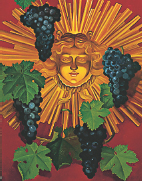
Cabernet Sauvignon
Aristocratic and magnificent, Cabernet Sauvignon is represented here by the sunburst, the emblem of France’s king Louis XIV, also known as Le Roi Soleil or the Sun King. His brilliant court at the Palace of Versailles was filled with images of Louis’ glory. The painting captures Cabernet Sauvignon’s self-importance and regal position in the world of wine.
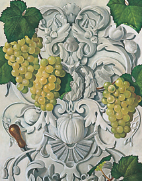
Chardonnay
There seem to be more flavours associated with Chardonnay than with any other grape and it also has a wonderful affinity with new oak barrels. So here carved in the fresh new oak are many of these flavours, including cloves, hazelnuts, warm brioche and a host of different fruits.
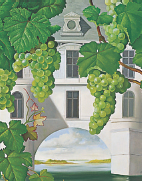
Chenin Blanc
Floating on air and water, the château of Chenonceau stretches across the river Cher in Touraine, with the river Loire beyond. Chenin Blanc was first planted here in the heart of the Loire Valley in the 15th century and Anjou and Touraine are still where it produces its most exciting wines, whether sweet or dry, sparkling or still.
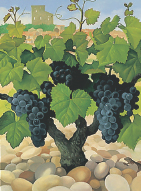
Garnacha Tinta/Grenache Noir
High on the skyline loom the gaunt ruins of the castle built by the popes during their sojourn at Avignon in the southern Rhône, instead of Rome. This was their new castle, their château neuf – and the vineyards spread around the castle walls are those of Châteauneuf-du-Pape. Gnarled old Grenache vines grow in a soil covered in large white pebbles or galets roulés that retain the heat of the southern sun long into the night. The pebbles make good homes for lizards, too.
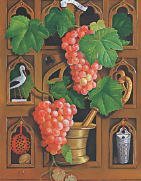
Gewürztraminer
The Gothic-style, carved wooden spice cabinet, stork, and buttery, knot-shaped sweet pretzels suggest Alsace where the grape achieves its highest fame. The pomander, cloves, nutmeg and spice mortar are references to the word ‘Gewürz’ which means spice in German but Gewürztraminer is a complex story. The wines are far more than just being fat and spicy, famous only for their heady perfume.
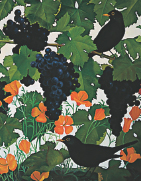
Merlot
Merlot’s name is said to be derived from merle, French for blackbird, which apparently loves its sweet, early-ripening fruit. Being planted like fury around the world, Merlot has done particularly well in the Napa Valley where the California poppy, as orange as a blackbird’s bill, grows wild.
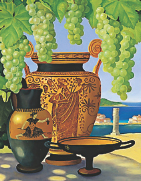
Muscat
The wine-dark sea around the island of Samos, a home of the Muscat grape, lies in the distance. Was this the wine drunk by Dionysus, the Greek god of wine? The ancient Greeks clearly loved wine and all its paraphernalia. Here is a mixing jar, a wine jug and a beautiful kylix, or two-handled wine cup. And goodness me, some hooligan has been scrawling his name on the side of the cup. Disgraceful.
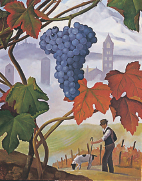
Nebbiolo
Dusty purple grapes and bright red leaves seen against a background of snow and fog – this is the Piedmontese town of Alba, famous for red wine and white truffles, in autumn. Against a backdrop of snow-capped Alps, the town’s medieval towers emerge from the late autumn fogs or nebbie that have given the Nebbiolo grape its name. In late autumn truffle hunters and their specially trained dogs set off into the oak forests bordering the vineyards in search of the revered delicacy.
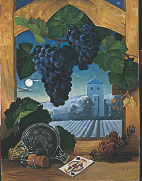
Pinot Noir
Seen through an arched Gothic window from the Hospices de Beaune in Burgundy, Pinot Noir’s homeland, is the château at Gevrey-Chambertin, one of the Côte de Nuits’ best known wine villages. The moonlit scene is a tribute to the word ‘Nuits’. On the windowsill are various references to Pinot Noir – a silver Burgundian tastevin or tasting cup, a Champagne cork and wire cage, an Oregon pine cone and a Knave of Spades to illustrate Pinot Noir’s capriciousness.
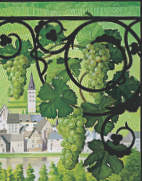
Riesling
On the banks of the river Mosel stands the town of Bernkastel directly behind which climb steep Riesling vineyards, just like the ridged green stem of the traditional Mosel wine glass. The intricate ironwork shop signs typical of the Mosel region were surely originally inspired by coiling vine tendrils.
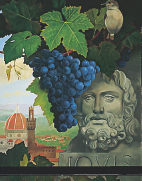
Sangiovese
Sangiovese means literally the ‘Blood of Jove’. Nice to think that this Roman god left off seducing mortals and dropping thunderbolts to give his name to this vine. Almost certainly of Tuscan origin, Sangiovese is still central Italy’s most important grape. Florence, the heart of Tuscany, lies beyond and Keats’s nightingale has strayed from Provence as this grape seems to give more truly ‘a beaker full of the warm south’.
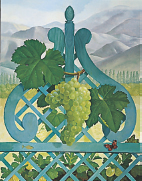
Sauvignon Blanc
A piece of the trellis from the potager garden at the château of Villandry illustrates the Loire Valley’s long association with Sauvignon Blanc. The flavours of Sauvignon Blanc are linked to myriad fruit and vegetables but none more so than gooseberries. Behind the trellis stretch the vineyards and hills of the Marlborough region in New Zealand’s South Island, the world’s new classic area for Sauvignon Blanc.
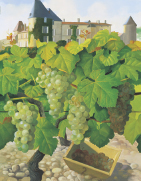
Sémillon
Seen here in the honeyed autumnal light evocative of its precious golden wine, Château d’Yquem is the supreme example of the majestic sweet wines of Sauternes. Pickers will go through the vineyards four times or more during the harvest, picking fully botrytized grapes or even green ones, according to the constantly changing instructions from the winery.
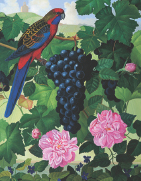
Syrah/Shiraz
Whether it originated in the northern Rhône, in Syracuse in Sicily or was brought back from Shiraz in Persia, there is something exotic about this grape. It’s a nice idea that Syrah reached Europe at roughly the same time as the damask rose, and along the same route. In the distance is the chapel on the Hermitage hill above the Rhône and in the foreground some of the wild violets that seem to perfume the wine. The parrot is an Adelaide Rosella from the Barossa Valley where Shiraz excels.
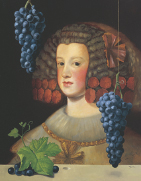
Tempranillo
The history and grandeur of Tempranillo is conveyed by references to two Spanish artists of the 17th century: first, Diego Velázquez, the great Spanish court painter whose paintings of the royal family, including the Infanta Maria Teresa depicted here, were much admired at the time, and second, Juan Sánchez Cotán who is best known for his still lifes with their detailed realism.
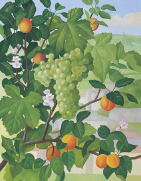
Viognier
If a wine can be described as pretty without insulting it, then Viognier is pretty. It tastes deliciously of the apricots that grow along with Viognier on the banks of the Rhône at Condrieu. There is a theory that the vine arrived by boat, along with Syrah, during the Roman occupation, found a landing place at Condrieu and then remained there as a tiny island of distinctive taste until its recent global explosion. Château-Grillet, a tiny estate in Condrieu, can be glimpsed behind the apricot fruit and blossom.
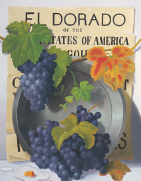
Zinfandel
Zinfandel, now known to be the same as southern Italy’s Primitivo grape, may have come to the eastern seabord of the USA with Italian immigrants. From there it made the journey west to California with the Gold Rush – hence the gold pan, the poster advertising the Gold Fields – the new El Dorado – and the nugget of gold. The popularity of the grape has proved to be a more lasting national treasure than the seams of gold which fast ran out.
















